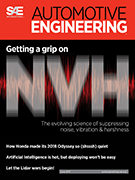Technical Paper
Object Detection and Tracking Based on Lidar for Autonomous Vehicles on Highway Conditions
2022-12-22
2022-01-7103
Multiple object detection and tracking are central aspects of modeling the environment of autonomous vehicles. Lidar is a necessary component in the autonomous driving system. Without Lidar sensors, we will most probably not see fully self-driving cars become a reality. ...In advanced driver assistance systems or automated driving systems, 3-D point clouds from lidar scans are typically used to measure physical surfaces. Lidar is a powerful sensor that you can use in challenging environments where other sensors might prove inadequate. ...Lidar is a powerful sensor that you can use in challenging environments where other sensors might prove inadequate. Lidar can provide a complete 360-degree view of a scene. This paper designs Lidar based multi-target detection and tracking system based on the traditional point cloud processing method including down-sampling, denoising, segmentation, and clustering objects.




